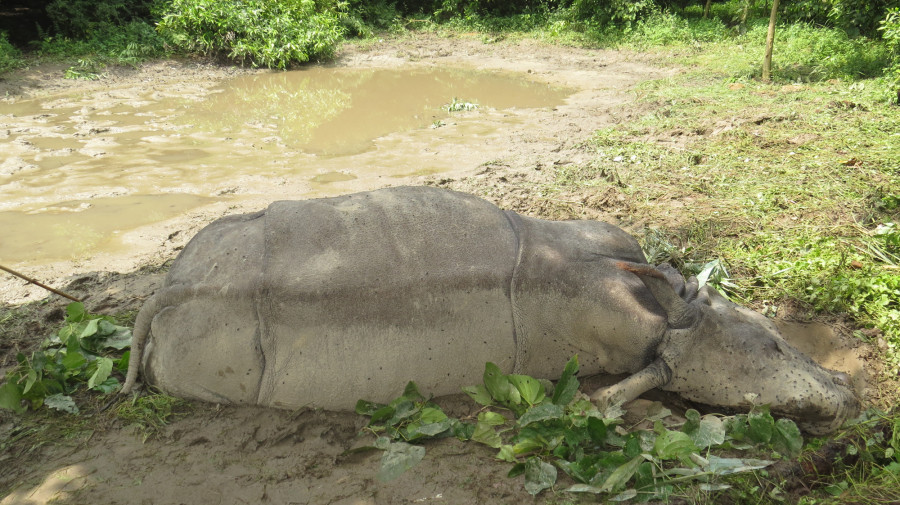National
Killing of a one-horned rhino after 41 months of zero poaching is worrisome for conservationists, authorities
The death of a rhino in Chitwan National Park leaves conservationists fearing pandemic might see a new start of poaching incidents similar to the past if unchecked.
Chandan Kumar Mandal
A one-horned rhino has been killed in Nepal after 1,249 days.
It may be a long time since the last time a rhino was killed but it has worried conservationists reminding them of a time rampant poaching of the wildlife in the country's protected areas when the country was facing another crisis in the form of an armed civilian conflict.
On Tuesday, a rhino of about 20 years of age was found dead in Laukhani post area of Nawalparasi inside Chitwan National Park.
According to Haribhadra Acharya, a spokesperson of the Department of National Park and Wildlife Conservation, the rhino succumbed to the injury caused by a gunshot on its head.
“Park officials had heard a gunshot a few days ago,” Acharya, who is also an ecologist with the department, told the Post. “We did not find the bullet at the crime scene but the post-mortem report confirmed that the rhino succumbed to injury caused by a bullet.”
“Since the rhino’s horn and other parts were intact at the scene, although poachers killed it, the parts could not be sold in any illegal trade.”
The death by gunshot wound after the longest ever gap on record has nonetheless come as a shock for conservationists in Nepal, since this could be an indication of more poaching while security forces are focussed elsewhere.
“We have witnessed a similar pattern before 2006 when the country was in the midst of armed conflict which saw a massive loss of wildlife,” said Kumar Paudel, a wildlife crime researcher. “This and other incidents of seizing of wild animal parts from different parts of the country indicate how the nationwide lockdown has seen an increase in poaching.”
There have been reports of movements of poachers and instances of poaching inside protected areas.
Days after Nepal went into the lockdown, security forces killed a poacher in Parsa National Park on March 27. In April, six Himalayan musk deer, an endangered species, were found dead inside Sagarmatha National Park.
Since 2006, however, poaching incidents have gone down drastically with the country celebrating zero poaching years for rhinos several times in the recent past. Zero poaching year means 365 days without a single rhino killed by poachers.
Since achieving the first zero poaching year in 2o11, the country has achieved zero poaching years on six other occasions— in 2014, in 2015, in 2016, in 2018, in 2019 and in 2020.
Before the latest killing and the 2017 incident, the last rhino was killed on May 3, 2014.
According to the 2015 rhino census, the latest year for which figures are available, Nepal is home to 645 rhinos—605 in Chitwan, 29 in Bardiya National Park, eight in Shuklaphanta National Park, and three in Parsa National Park.
Thousands of rhinos once roamed the jungles of southern plains before their number fell sharply in the 1950s and the 1960s. The rhino population slowly recovered with the establishment of Chitwan sanctuary in 1973.
However, the decade-long armed conflict and political instability once again saw a massive decline in the population of rhinos and other wildlife in protected areas.
Rhino conservation suffered its worst during the decade-long armed conflict between 1996 and 2006 when 157 rhinos were killed by poachers.
Forty-eight rhinos died in each of the fiscal years 2001-02 and 2002-03. Of these, 37 were killed by poachers in 2001-2002 and 32 the next year. In the past 22 years, a total of 502 one-horned rhinos have died inside Chitwan National Park from various causes.
Rhino horn grounded into powder is believed to cure cancer and other diseases in Chinese medicine and fetches up to USD60,000 per kilo on the black market.
In the last few years, when illegal poaching of rhinos had been largely controlled, the unprecedented surge in natural death of rhinos has come as a new challenge.
There has been an unprecedented rise in the death of rhinos due to natural causes in the last four years. In the fiscal year 2016-17, 25 rhinos were reported dead, including one killed by poachers. Twenty-six rhinos died in the following fiscal year 2017-18, 43 in 2018-19, and 26 in 2019-20.
Before this sudden surge, the number of rhino deaths due to natural causes was around 15 annually, according to government data.
The ongoing pandemic and restrictions have added a new challenge for rhino conservation, say conservationists.
“In the aftermath of the Covid-19, people working abroad and in urban areas have gone back to their villages. Illegal poaching of the wildlife for easy and extra money could motivate them to kill wildlife,” said Paudel, who is also the co-founder of Greenhood Nepal, a science-driven nonprofit that focuses on the human dimensions of conservation.
Paudel’s own research published earlier this year concluded that poverty alone was not the leading cause for involvement in illegal wildlife trade.
“Illegal poaching of wildlife has significantly increased even in South Asian and African countries,” he said. “There have been instances of selling of wild animal parts on social media platforms even in Nepal. Since people have more free time and it also brings extra income they are getting engaged in such activities.”
Incidents of wildfire, poaching of wildlife and deforestation were on the rise in several forests in Tarai districts in the earlier phase of pandemic-induced lockdown.
Conservationists had earlier warned such activities could threaten the country’s green cover and wildlife population that reside in those areas.
In May, a group of conservationists, associated with Society for Conservation Biology Nepal, a non-governmental organisation of professional conservationists, had expressed its concern about how the Covid-19 pandemic was threatening Nepal’s years of nature conservation achievements, with potential repercussions for years to come.
Prakash K Paudel, a conservation biologist and president of the society, sees the latest rhino killing as a warning sign of what may be coming in the near future.
“The recent killing can also be interpreted as testing the waters. Poachers work in a specialised and organised network. They might have tried to experiment with this incident to see whether it could be done or not and how the authorities would respond,” said Paudel.
There is a risk that the Covid-19 pandemic might turn out to be an excuse for normalising rampant killing of valuable wildlife like endangered one-horned rhinos and for imperiling the country's success story in conservation.
“Anti-poaching activities require coordinated action from local level to central agencies and security forces. But it seems they lack motivation because they are not getting clear direction from the leadership. There are reports of political interference as well,” said Paudel. “With the pandemic, every aspect of life has been affected. Conservation staff are on the field 24 hours but their benefits have not been increased. Therefore they may be less motivated.”
The Department of National Park and Wildlife Conservation has been without the director general since late April.
According to Paudel, the wildlife crime researcher, the enforcement priority and ground presence of security might have taken a hit during the pandemic.
“This is clearly sending out a message that when there is weaker enforcement and less mobility of security personnel, which might be due to health precautions, wildlife trade can go up,” said Paudel. “If our conservation efforts were backed by communities, as authorities claim, people in communities would not have allowed poaching and such incidents would not have happened. Not all the wildlife crimes are part of international organised crime, some are taking place at the community level for easy and extra income.”
But according to Acharya, the ecologist with the department, there has been no significant trend suggesting an increase in poaching and illegal trade of wildlife parts during the lockdown.
Admitting that there may have been attempts to kill wildlife taking advantage of the current crisis, Acharya said that since there are no means of transportation of wildlife parts, their trade is also affected.
“This killing of the rhino is worrisome,” he added.
“People who are free and unemployed can be used for wildlife crime like in the latest case although such activities take place even when people are busy and employed,” said Acharya. “We need to increase patrolling on the ground and procure information to crack down on such incidents.”




 15.69°C Kathmandu
15.69°C Kathmandu






%20(1).jpg&w=300&height=200)






